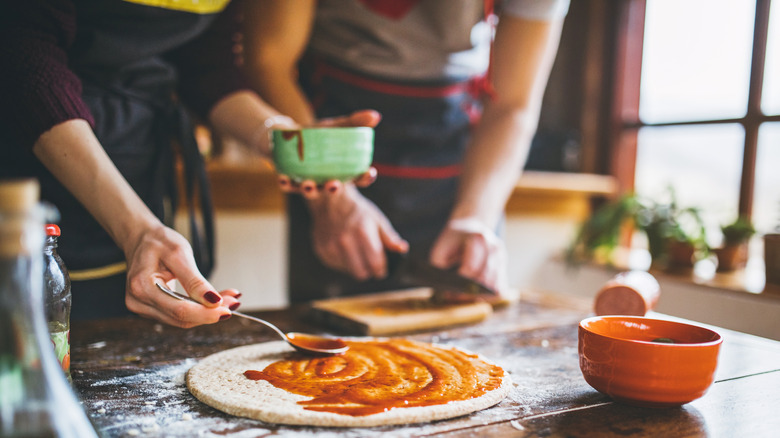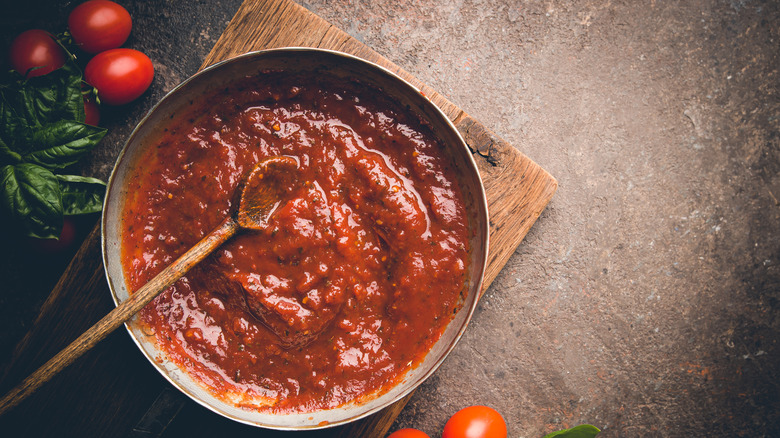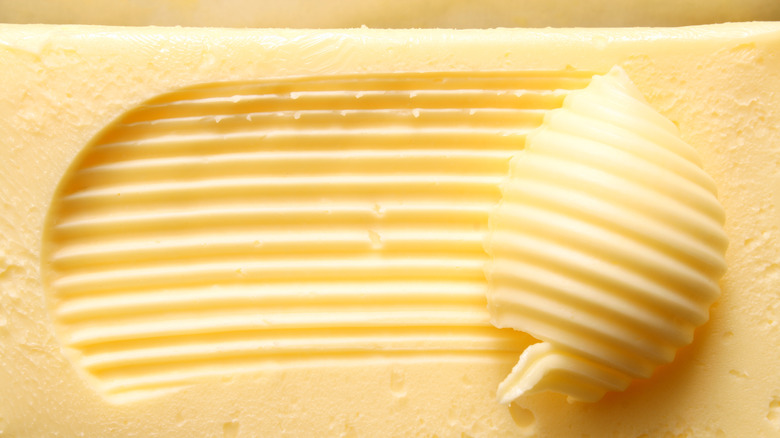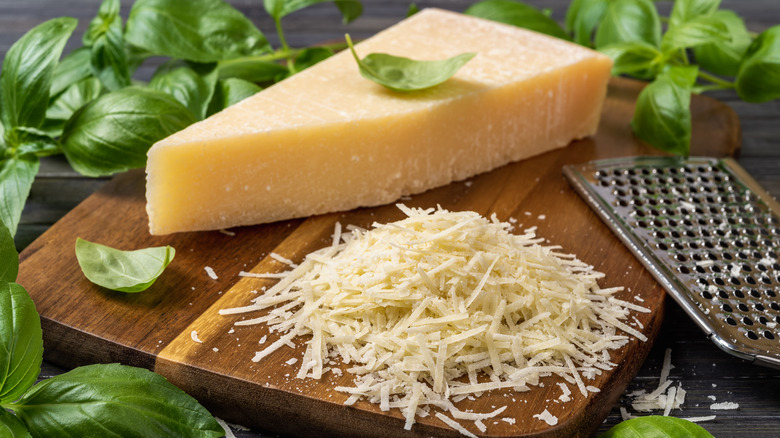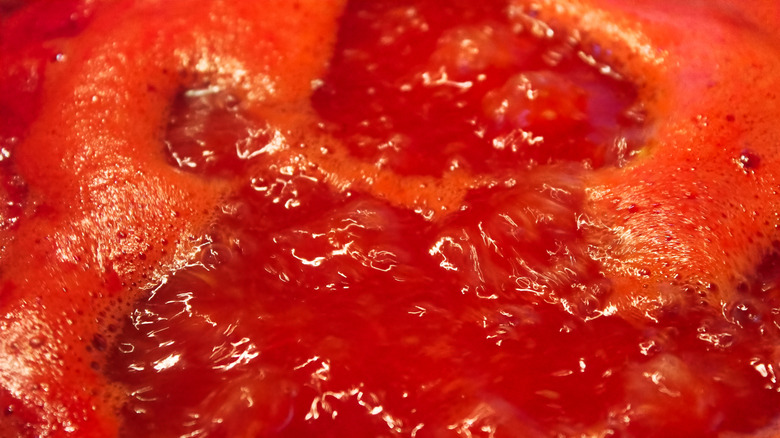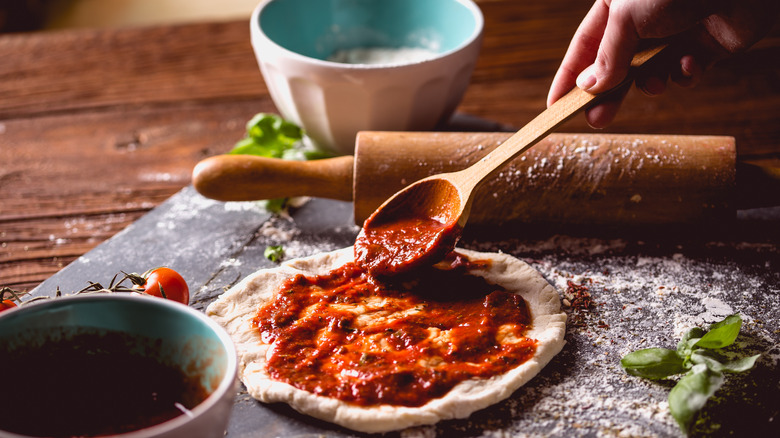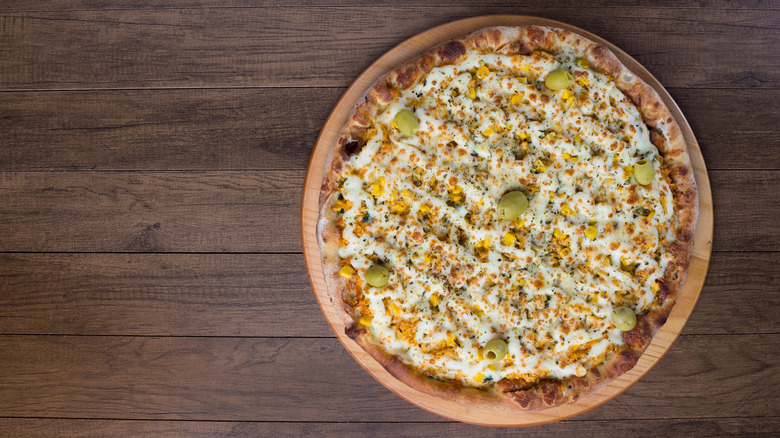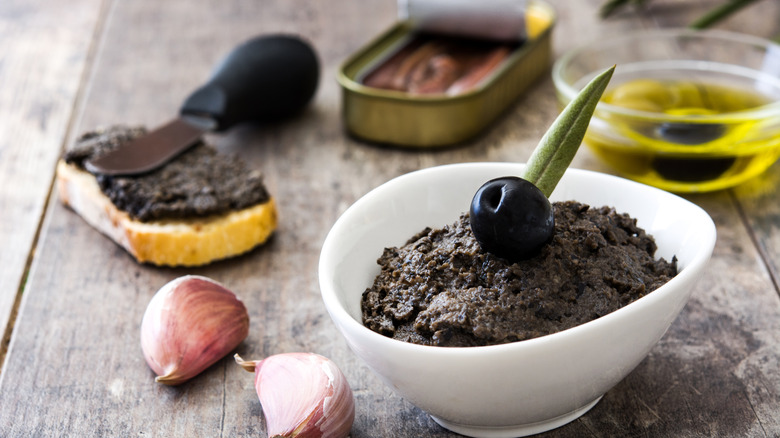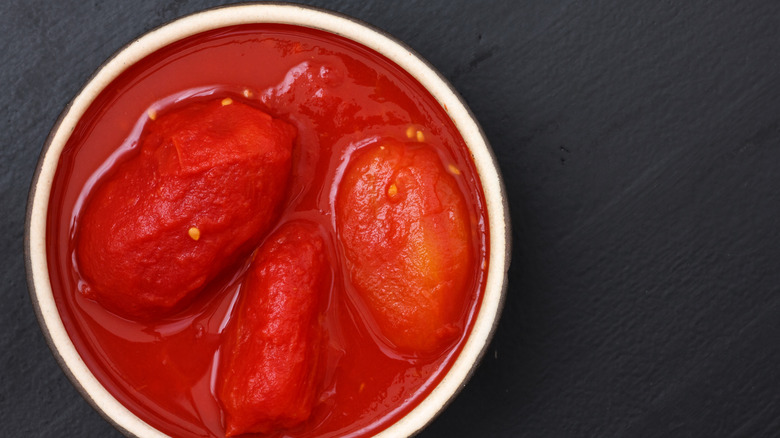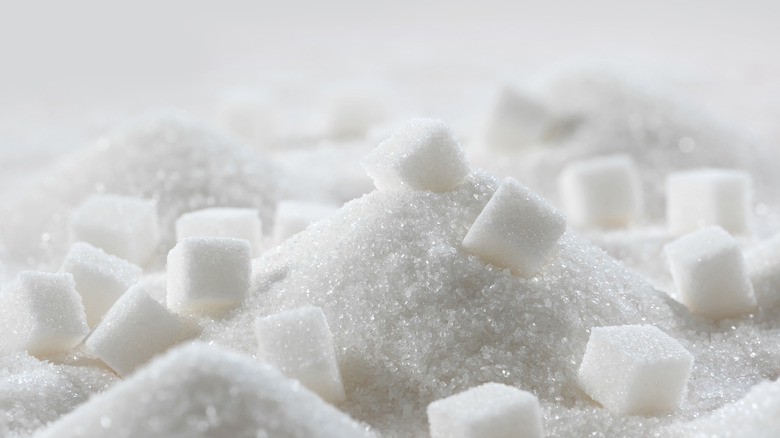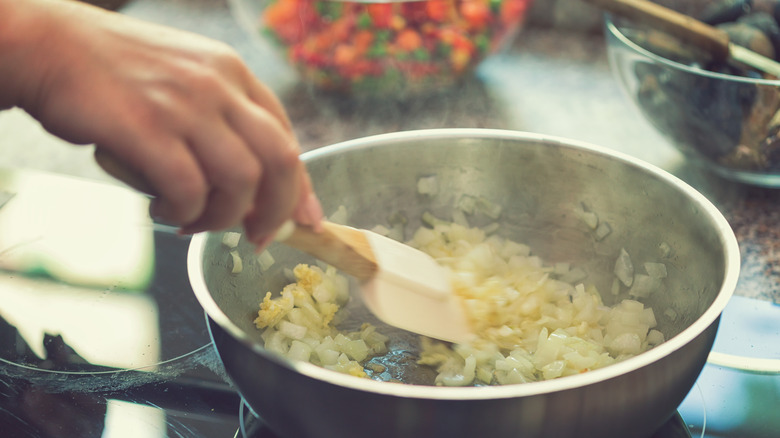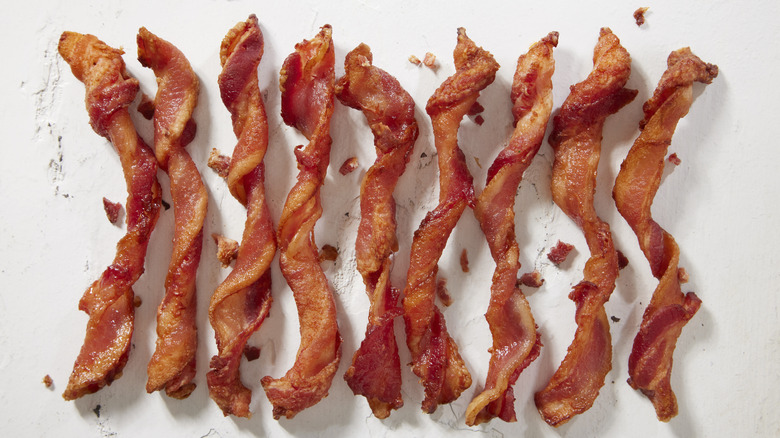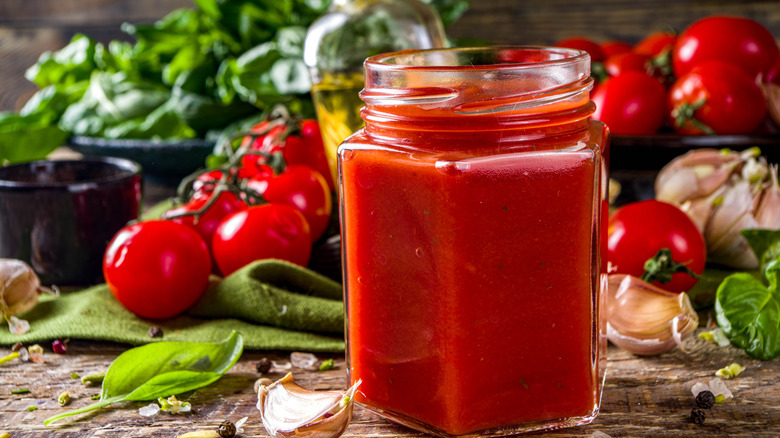15 Tips You Need When Making Your Own Pizza Sauce
Making homemade pizza is a very ethereal experience best shared in the company of friends and loved ones. You get to and play an integral part in every step of the way — from picking and choosing your favorite toppings to forming the dough and firing up your pie. While there are many ingredients that you can easily buy from a grocery store (seriously, dealing with a sticky homemade pizza dough that never seems to rise perfectly isn't a fun time), pizza sauce is not one of them.
Pre-made pizza sauce is one of those essential ingredients for your pie that always has some flavor imbalance to it. You may find some brands of pizza sauce taste like sugary gloop or obscurely tomato-y. Rather than going store-bought, we recommend taking the time to make your own batch from scratch. Here are some of our best tips for mastering pizza sauce at home.
1. Don't confuse pasta sauce with pizza sauce
We should first start by making clear the big difference between pasta sauce and pizza sauce. Pizza sauce is most often uncooked, while pasta sauce is almost always cooked. If you look on the label of a pizza sauce jar, you'll likely see crushed or pureed tomatoes, seasoning, and potentially tomato paste as a thickener. Pasta sauce typically has a greater concentration of ingredients in it because it is eaten as the sole companion to pasta. Pizza sauce, on the other hand, can be mediated with cheese, crust, and toppings.
Why are pizza sauces often left uncooked? The reasoning is usually because of the oven's high temperature, which would cause cooked sauces to overcook or caramelize the tomatoes into a paste. Some pizza styles, however, rely on cooked pizza sauce, though, such as the Detroit style, where the sauce is poured on top of the glorified cheesy bread after it's finished cooking.
2. Use butter for a better flavor
We can confidently say that there isn't much in the cooking world that can't be improved without a pad (or two) of butter. Butter is the rich addition that will take your pizza sauce to the next level because it can subdue some of the astringent tomato flavors and create perfect harmony in your sauce.
There are several methods for adding butter to your tomato sauce. The first is to add the butter to your pizza sauce with the oil. You'll want to include the oil in addition to the butter rather than making a direct substitution because the oil is less rich in flavor but still helps cook down any aromatics you use. In addition, the oil also has a higher smoke point than using butter alone. You can also add your butter to the sauce after it's finished cooking and right before serving. This will ensure your sauce has a butter-forward flavor profile.
3. Get cheesy with parmesan
We welcome the idea of adding extra cheese to your pizza by way of a sprinkle of parmesan on top of your slice, but you should also consider adding it directly to your pasta sauce. It is the ingredient that will change your homemade pizza sauce forever because the cheese will add an unanticipated depth of flavor. From a textural perspective, adding cheese to your pizza sauce will also make it thicker and easier to spread on a pizza round. Thin, watery pizza sauce is undesirable because it will seep through the crust and cause soggy spots.
Parmesan offers the added benefit of offering an element of umami that will add complexity to your sauce. And while you can take the easy way out and use pre-ground cheese, it often contains anti-caking agents that can disrupt the texture of your sauce. Your best bet is to pull out your grater and do it yourself.
4. Add a sprinkle of nutritional yeast
If you want to maximize your pie's potential, an extra-flavorful pizza sauce will go a long way. And although you might consult your standard pizza sauce ingredients like herbs and basil, you should look to a more unconventional ingredient popular among vegans: nutritional yeast. Nutritional yeast, otherwise called "nooch," is an inactive brewer's yeast with a distinctly cheesy flavor. As advertised, it's a nutritional powerhouse of an ingredient and includes complete plant-based protein, vitamin B12, and trace vitamins, according to Healthline. It can be sold in flakes, granules, or powder form at most grocery stores or through online retailers.
You should consider adding a couple of tablespoons of nutritional yeast to your pasta sauces to both thicken it and combat some of the more dominant acidic flavors. The nutritional yeast won't make your sauce heavy, creamy, or dense, either. It's a suitable plant-based replacement for adding parmesan cheese to your pizza sauce.
5. Let your sauce sit before spreading it on the pie
Few individuals sling a more perfect pie than Chris Bianco, owner of the celebrated pizza empire that carries his name. One of Bianco's tips for making the perfect pizza sauce is to give the sauce enough time to rest and the flavors to meld together before spreading it on a pie. He doesn't cook the tomato sauces for pies like the margherita and will stick to high-quality, simple ingredients to make a delicious tomato sauce.
"We add some extra virgin olive oil, a little bruise of fresh basil leaves, and maybe the salt. Our tomatoes have a little bit of sea salt in them — possibly a turn of black pepper, and that's it," he told Tasting Table during an exclusive interview. "Leave that to sit for maybe 30 minutes before using, so that basil and the olive oil have a chance to activate the tomatoes that were already in balance and delicious."
6. Make a reduction for cooked tomato sauce
Some people will take the plunge and cook their pizza sauce before adding it to the pie. This method is in-line with variations like New York by-the-slice style or a Detroit pan pizza, but it must be done carefully to ensure that the sauce does not overcook and change its flavor too much. But, to avoid the bitter taste of overcooked tomato sauce, you should aim to include a lot of toppings to reduce the evaporation of the sauce any further.
We also recommend going a step further and making a reduction with your sauce. Reducing your tomatoes is the key to elevating homemade pizza sauce because it will make your sauce less runny and make the flavor more tomato-forward. To reduce the sauce effectively, cook it over a low flame for at least an hour, stirring occasionally to evaluate the thickness and consistency.
7. Don't skimp on the herbs
Your spice cabinet is one of the easiest ways to add more oomph to any of your dishes — pizza sauce included. You should be judicious when adding herbs to ensure you get a well-rounded flavor in your sauce. Some of the most popular options include Italian seasoning (basil, oregano, and rosemary), thyme, and sage. This leads to the question: Should you use dried or fresh herbs for tomato sauce? Arid herbs, like rosemary, marjoram, sage, and thyme, tend to have the same flavor, dried and fresh. If you're using these dried herbs, you'll want to allocate enough time for the herbs to soften in the sauce and release flavor.
One of our favorite unconventional ingredients to incorporate into pizza sauce (or pasta sauce, for that matter) is cinnamon. A popular addition to Greek-style tomato sauce, cinnamon boosts the sweetness and curbs acidity without necessarily adding sugar.
8. Think beyond the tomatoes
Although a traditional pizza is made with a red sauce, there's no reason why you can't color outside the lines with an innovative, tomato-less option. White pizzas are the general classification given to pies that don't utilize tomato sauce, but this title can be a bit misleading. For example, you can make a pesto pizza sauce with your favorite summer herb: basil. You should also use other greens to make pesto, like blanched kale, spinach, carrot tops, and a diversity of nuts and seeds like pumpkin seeds, pecans, and almonds. It's not a white pizza, but "green pizza" hasn't really caught on yet.
You can also stick to a creamy sauce rather than just a boring sprinkle of olive oil. Try making a roasted garlic white pizza sauce with butter, milk, and parmesan. It's a perfect complement to an upgraded cheese pizza or a pie with a ton of herbs.
9. Get fishy with anchovy paste
Beyond pineapple, anchovies are perhaps the most divisive of all pizza ingredients. While the tiny fish tend used as a topping, anchovy paste is one of the secret ingredients your homemade pizza sauce needs because it adds a strong umami flavor profile without having to plop the tiny filets on top of your pizza. You'll only need to add about one teaspoon of the paste to the rest of your sauce ingredients before letting the mixture sit for at least 30 minutes (preferably longer).
If the consistency and overpowering taste of the anchovy paste bothers you, consider adding a splash of fish sauce to your pizza sauce instead. It's made of fermented anchovies and is best used with cooked sauces. This allows the flavors to meld together a little bit more than getting hit with a fishy aftertaste as soon as you take a bite into your homemade pie.
10. Always use whole, peeled tomatoes
If you've perused the tomato aisle at the grocery store, you've likely come across a variety of canned options — diced, pureed, crushed, whole, roasted — but which one is best for making pizza sauce? For the most part, your best option is going to be whole canned tomatoes. These tomatoes are the least processed variety and are only cooked enough to peel. Diced tomatoes are not a good option for making your own sauce because they are often treated with calcium chloride to help the pieces retain their square shape in the container. As a result, these tomatoes don't tend to blend down well into a cohesive sauce.
If you can't find whole tomatoes, crushed or pureed are solid backups. Crushed tomatoes aren't always uniform in size, thus making it difficult to make a sauce out of them. Pureed tomatoes are cooked and strained, which is easy enough to make into a quick sauce, but tends not to be the best for long-term cooking.
11. Don't forget to add some sugar
There is a deep divide over whether to include sugar in any tomato sauce — pizza sauce included. As with any ingredient, moderation is key to making a balanced sauce with flavors that work together rather than compete. Southern Italians first started adding sugar to tomato sauce to account for the end-of-season tomatoes that did not adequately ripen, thus, were sourer than the ones from earlier in the season. In addition, tomatoes weren't bred out as a fruit as much in the past, so the older tomato varieties were much more tart than the ones grown today.
Out-of-season tomatoes or canned tomatoes tend to be the most acidic, thus, can really benefit from a pinch of sugar. The key to adding sugar, or an alternative sweetener like honey, is always to taste your sauce at the end of cooking and gradually add the sugar to the mixture.
12. Use wine to add depth to your sauce
If you want a pizza sauce that will stand alone above the rest, turn to your wine cabinet. Red wines, especially, can add an interesting depth of flavor that complements toppings like parmesan, roasted red peppers, meatballs, and sausage.
When choosing a wine for your pizza sauce, you should always choose a wine that you like to drink. Cabernets, zinfandels, and pinot noirs are some of the most popular types to add to pizza sauce because the flavors mesh well with the tomatoes. You'll want to add the wine to the sauce as it's cooking; this will slowly reduce, increase the wine flavor, and cook off the alcohol. You can also use a splash of wine to deglaze the pan after cooking down your garlic, onions, vegetables, or meat. This splash of liquid will help pick up any of the crispy caramelized bits while also infusing your wine's flavor into the sauce.
13. Use vegetables for texture and flavor
Adding garlic is standard for pizza and pasta sauces because it provides a bit of back-of-the-mouth heat and a slightly bitter flavor. If you're looking for a more mellow garlic flavor, consider adding roasted garlic to the sauce or keeping your cloves whole, adding them to the sauce, and straining the cloves out when you are ready to spread it on your crust. This is because the more you cut and crush garlic, the more allicin is released, which is the chemical responsible for the garlic's pungent flavor.
Other vegetables to consider adding to your pizza sauce are onions, red peppers, carrots, zucchini, and spinach. Add the harder chopped veggies first to allow them to cook down, then move to your soft veggies and other ingredients. After the sauce is cooked and the veggies are tender, puree the sauce using an immersion blender to get the smooth pizza sauce consistency.
14. Make friends with bacon and pancetta
If you can't make a dish better with butter, you can probably make it better with bacon. Adding cooked bacon to your pasta sauce is an easy way to amp up the meaty flavor of your pizza — especially if you're going to top it with pepperoni, sauce, meatballs, or even more bacon.
There are different methods for adding bacon to your sauce. The first involves using bacon drippings as fat to cook your garlic, onion, and vegetables. While this method is a great way to repurpose bacon drippings, it can impart a greasy film on your lips and teeth. Instead, we recommend adding thick-cut bacon pieces directly to the pot, cooking it, and then removing it and cooking the onions and garlic in the remaining fat. Then, add your bacon back into the sauce at the end of the cooking process. The key is to cut the bacon into tiny pieces to ensure that it is distributed throughout.
15. Take time to store your pizza sauce properly
Most pizza sauce recipes make enough sauce to last several pizzas. After all, why would you go through the arduous task of making pizza sauce for just one pie? If you're making a batch of pizza sauce, you must store it correctly to ensure your next pizza pie won't make you sick. After adequately cooling down your sauce, store it in the refrigerator for five to seven days. If you can't eat it within that timeframe, your next best option is to freeze it.
Tomato-based sauces freeze very well, but you must undergo essential steps to ensure the sauce stays fresh. When you ladle it into the container, always be sure to leave a couple of inches of space on top since the sauce will expand as it freezes. You can also freeze the sauce in an ice cube tray and transfer it to a freezer bag once it's adequately frozen; this is the perfect serving size for an individual pizza. When you're ready to use, thaw the sauce in the fridge overnight. This is the safest thaw method to reduce the risk of foodborne illness.
